Infirrera
Italo-Portuguese-suited cards by Andrea Infirrera with the arms of Malta, 1693.
The "Portuguese suit system," also referred to as the "Italo-Portuguese system," was once widely used in Portugal, Sicily, Malta, and other regions connected to Portuguese colonization and trade. However, this system is now largely outdated. It is worth noting that the boundaries and simultaneous diffusion of the different variations within these regions and Europe as a whole are not clearly defined. Moreover, this system had an impact on Far Eastern countries, including Japan. Additionally, remnants of the Portuguese suit system can still be found in early Spanish and Italian playing cards, specifically in Minchiate packs, while it continues to be preserved in the Sicilian tarot to this day.
Malta was ruled by the Order of Saint John as a vassal state of the Kingdom of Sicily from 1530 to 1798. A thriving playing-card manufacturing industry had flourished there since 1684. The example of cards with dragon aces shown here is believed to have been made by a Spanish cardmaker, A.Infirrera, whose name is on the four of cups, whilst the date 1693 appears on the two of coins. The kings have Maltese crosses on their chests and the four of coins has arms said to be those of the Grand Master of Malta of that time.
The cards have a centrally-placed index at top and bottom, placed within a rectangle, and there is also an inner rectangle in the design of each card. The index letters refer to the card rank and suit names in Italian (rather than Portuguese). The kings are seated and hold shields. The maids also hold shields and those of swords and batons are battling with serpent-like creatures, similar to those depicted on the aces.

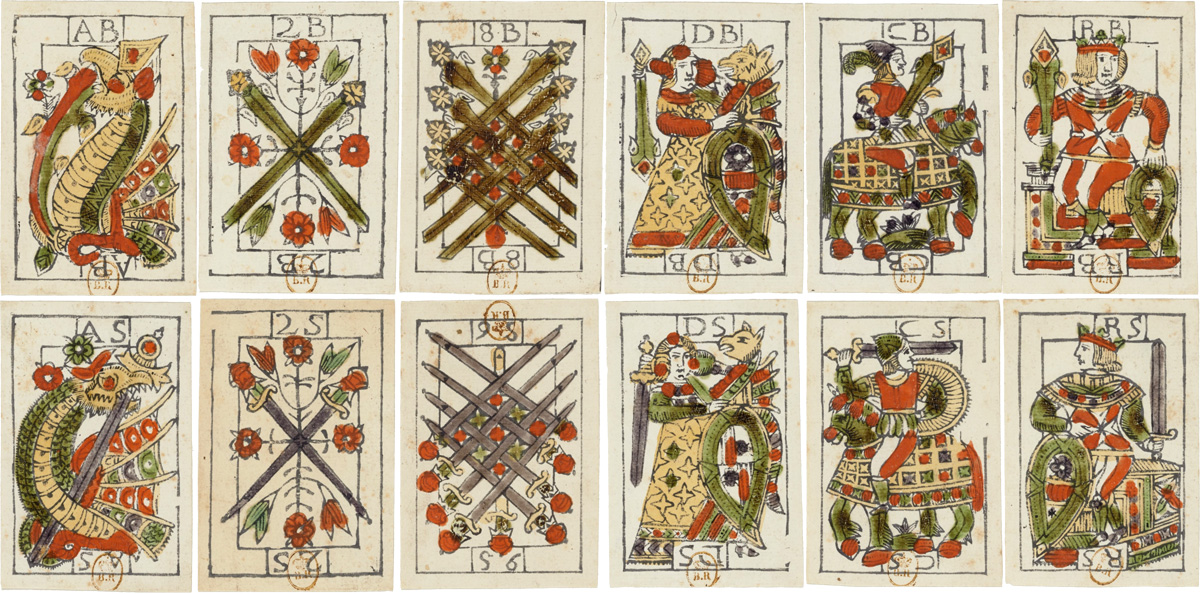
Above: Portuguese-suited cards by Andrea Infirrera with the arms of Malta, 1693. Source gallica.bnf.fr / Bibliothèque nationale de France • Jeu de cartes maltais aux dragons de type portugais►
Further References
Denning, Trevor: “What Are Infirrera Cards?” in The Playing-Card, Journal of the IPCS, Vol. 16 number 3.
Salvatore Bonaccorsi, Nicola De Giorgio, Emilia Maggio: The origins of the "Portuguese" suit system for playing cards and tarots in Sicily Section II►
Giovanni Bonello: “Maltese Playing Card Makers 1684-1750” in The Playing-Card, Volume 32, Number 3, IPCS 2005.
By Simon Wintle
Spain • Member since February 01, 1996 • Contact
I am the founder of The World of Playing Cards (est. 1996), a website dedicated to the history, artistry and cultural significance of playing cards and tarot. Over the years I have researched various areas of the subject, acquired and traded collections and contributed as a committee member of the IPCS and graphics editor of The Playing-Card journal. Having lived in Chile, England, Wales, and now Spain, these experiences have shaped my work and passion for playing cards. Amongst my achievements is producing a limited-edition replica of a 17th-century English pack using woodblocks and stencils—a labour of love. Today, the World of Playing Cards is a global collaborative project, with my son Adam serving as the technical driving force behind its development. His innovative efforts have helped shape the site into the thriving hub it is today. You are warmly invited to become a contributor and share your enthusiasm.

Related Articles

Portuguese pattern by Real Fábrica
Later Portuguese pattern by Impressão Règia, Real Fábrica de Lisboa.
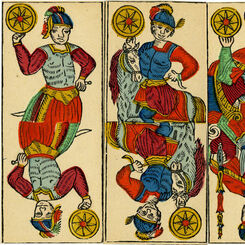
Trappola pack by Anton Herrl
Trappola pack of 36 double-ended cards published by Anton Herrl, Graz, Austria.

Early German playing cards
Some early examples of popular German playing cards from the XV and XVI centuries.

Auvergne Pattern - Portrait d'Auvergne
The Auvergne pattern is one of the oldest in France.

Portuguese cards for Brazil
Portuguese-type cards made in or for Brazil, c.1890.

Vittoriosa Church Museum
Antique playing cards in Vittoriosa Church Museum dating back to the Knights of Malta period.
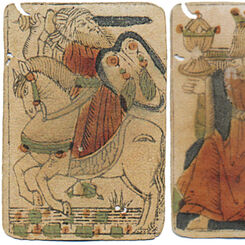
XV Century Spanish-suited playing cards
XV Century Spanish-suited playing cards with moorish influences

Cartas Portuguezas
Portuguese pattern playing cards published in Rio de Janeiro, Brazil, late 19th century.
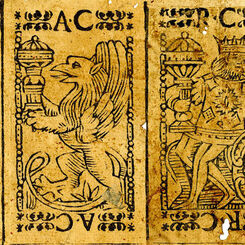
Portuguese-suited cards
Portuguese-suited cards with dragon aces, made in Italy, 1613.
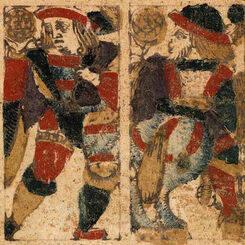
Toledo, 1584
Archaic Spanish-suited deck with 48 cards made in Toledo in 1584.

Master of the Playing Cards
Animal suited playing cards engraved by the Master of the Playing Cards, Germany, c.1455

Hewson
Antique English woodblock playing cards by a card maker named C. Hewson, mid-17th century.

Portuguese pattern
19th century Portuguese pattern, re-printed from original woodblocks.

Malta
The so-called ‘Dragon Cards’, with winged monsters on the four Aces, are an enigmatic aspect of earl...

French Playing Cards
Some of the oldest cards still in existence come from France. During the 16th and 17th centuries Fra...

Francisco Flores
Playing cards in this style have been discovered in various parts of the world, suggesting that they...
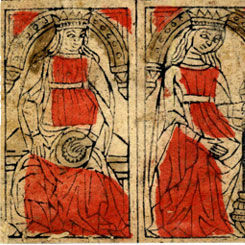
XV Century Italian Playing Cards
Cards from a pack of an early form of north Italian playing cards, with the swords back-to-back and ...

Early Spanish/Portuguese type
Fragment of a sheet of archaic Spanish-suited 'Dragon' playing cards found during restoration of a h...

Portuguese Type Playing Cards c.1860
10 cards from a pack of later Portuguese ‘Dragon’ type cards from c.1860, with the Maid of batons ab...

16th century cards discovered in Peru
Fragments of playing cards and 2 dice were unearthed in a 16th century rubbish tip adjace...
Most Popular
Our top articles from the past 60 days






















